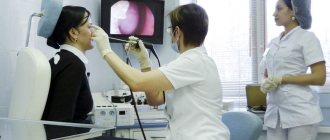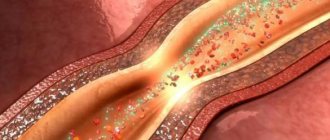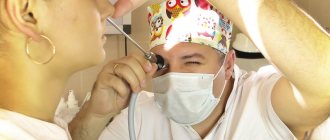A careless attitude towards a common runny nose or cold can provoke the development of sinusitis. Sinusitis is an inflammatory process in the maxillary paranasal sinuses. Another name for them is sinusitis, hence the name of the disease - “sinusitis”.
The maxillary sinuses are located to the right and left of the nose, in the area of the cheeks under the eyes. Healthy, uninflamed sinuses are cavities filled exclusively with air. The mucous membrane of the sinuses secretes the required amount of mucus, which enters the nasal cavity through small openings - anastomoses. But if bacteria are activated in the sinuses, in response to the actions of pathogenic microflora, the mucous membrane of the sinuses swells, the anastomosis closes, and the release of mucous masses becomes impossible. Pus accumulates in the sinus, and severe inflammation starts.
What symptoms does the patient complain of during sinusitis? Why does the disease occur, and what signs of sinusitis should you pay attention to? “Sinusitis: symptoms in adults” is the topic of today’s article.
Reasons for the development of sinusitis
Sinusitis is caused by an infection that gets into the maxillary sinuses. There are cases when bacteria already inhabit the mucous membrane of the human nasopharynx, but their concentration is not enough to negatively affect the body. But as soon as certain factors appear, pathogenic microorganisms turn from a harmless “neighbor” into an enemy: they begin to multiply intensively and carry out their life activities. This is how the inflammatory process starts, sinusitis develops, and the symptoms of the disease make themselves felt.
What factors cause inflammation of the maxillary sinuses?
- infectious diseases of the nasopharynx;
- untreated runny nose;
- poor oral hygiene and dental diseases (for example, caries);
- hypothermia;
- allergic rhinitis;
- deviated nasal septum;
- formations in the nasopharynx (for example, polyps);
- adenoids;
- nasal injuries;
- inhalation of harmful substances (usually in industries);
- weakened immune system;
- tumors of the nasal cavity;
- tuberculosis;
- frequent use of vasoconstrictor nasal drops.
Make an appointment right now!
Call us by phone or use the feedback form
Sign up
It has been scientifically proven that the larger the size of the sinus, the easier it is for pathogenic microflora to get there. The maxillary sinuses are the largest, so they are susceptible to inflammation much more often than other paranasal sinuses.
Sinusitis: symptoms
In order to recognize the problem in time and contact an ENT doctor, it is important to be able to recognize the signs of sinusitis.
A distinctive sign of sinusitis is headaches and pain in the maxillary sinuses. The patient experiences pain in the cheek area under the eyes. He feels an unpleasant pressure on the bridge of his nose. By evening the pain becomes much stronger. Discomfort in the sinus area also increases when turning or tilting the head. Painful sensations are explained by the presence of pus in the sinuses. The purulent masses become crowded, and they put strong pressure on the walls of the sinuses. With severe inflammation, pain can radiate to the jaw, temples and other parts of the face.
The disease is often accompanied by nasal discharge. At the initial stage they are transparent, but quickly acquire a greenish tint and become viscous. Green snot indicates a bacterial infection in the nasal cavity. There may be no discharge at all if the sinus openings are completely blocked and the mucus and pus cannot come out.
Many patients experience an increase in body temperature to high levels (38.5°).
The patient also has:
- loss or deterioration of sense of smell;
- swelling in the area of the eyelids, eyes, nose;
- nasal voice;
- nasal congestion;
- weakness, fatigue, lack of performance.
These were the general signs. If you have sinusitis, the symptoms will depend on the type of disease.
Sinusitis happens:
- According to the location of inflammation:
- unilateral (right- or left-sided);
- bilateral.
- According to the nature of the flow:
- sharp;
- chronic.
- traumatic;
- allergic;
- odontogenic;
- rhinogenic;
- hematogenous;
- viral;
- bacterial;
- fungal.
- catarrhal;
- exudative;
- purulent;
- polyposis.
There are many classifications of the disease. Let's look at the most common types of sinusitis and the symptoms of these forms.
Acute sinusitis.
The acute form develops very rapidly. They are very intense and knock the patient out of his usual life. Body temperature rises. It happens that it reaches 38-39°C. This is explained by the fact that pathogenic organisms in the sinus begin to actively multiply, and the human body tries to cope with them on its own.
The second characteristic sign of the disease is pain. The cheeks hurt in the sinus area, the bridge of the nose hurts, and pain in the jaw may appear. If the patient tilts or turns his head, sneezes or coughs, the pain intensifies. In the evening this condition worsens.
In some cases, photophobia occurs. Mucus is discharged from the nose. If bacterial flora is raging in the sinus, the discharge is green, which indicates a purulent process.
It becomes very difficult to breathe through the nose, severe congestion occurs. The patient's eyelids swell. The patient feels overwhelmed, lethargic, and cannot carry out his usual activities.
Chronic sinusitis
The chronic form of the disease occurs if the acute form is not fully treated. Chronic inflammation is a sluggishly developing process that lasts more than a month. The symptoms are blurred and clearly manifest themselves only during an exacerbation.
During an exacerbation, the patient complains of the following symptoms:
- low-grade body temperature (up to 37.5°C);
- nasal congestion, which may go away during the day;
- purulent discharge from the nasal cavity;
- pain not only in the bridge of the nose, but also in the jaw area;
- nasal voice;
- weakness, fatigue.
During the period of remission, the disease is more difficult to recognize. Symptoms are not so intense:
- nasal congestion;
- accumulation of mucus in the throat, which drains from the nasopharynx;
- headache;
- swelling of the eyelids in the morning after sleep;
- impaired sense of smell.
Traumatic sinusitis
The cause of the development of this form of the disease is severe trauma to the skull, which is often accompanied by damage to the nasal septum. Due to heavy bleeding, blood clots can get into the maxillary sinuses. If the problem is not identified in a timely manner, an infection may develop and suppuration may develop. Polyps and growths can form in a sinus that is inflamed after an injury.
The patient's body temperature rises and headaches appear. The inflammatory process can spread to neighboring tissues, causing the formation of phlegmon or abscess (suppuration). Treatment of this form is carried out inpatiently.
With chronic inflammation, a person complains of pain in the sinuses, congestion, and nasal discharge. Swelling of the eyelids and swelling of the cheek on the side of the affected sinus may be observed. A fistula (fistula) may form in the infraorbital region with pus discharged from there. Patients with this diagnosis undergo sinus surgery to remove fistulas and polyps.
Friends! Timely and correct treatment will ensure you a speedy recovery!
Allergic sinusitis
The cause of the allergic form of the disease is contact of the sinus mucosa with an allergen (an irritating substance).
The disease resembles a manifestation of classic allergies. The main features of this form are:
- persistent cough that does not go away even after taking antitussive medications;
- impaired nasal breathing;
- nasal congestion;
- mucus from the nose;
- bouts of sneezing;
- swelling;
- itching in the eyes.
Irritating substances can be dust, animal hair, pollen, cosmetics, etc. It is necessary to identify the allergen as quickly as possible and eliminate its effect on the body.
Odontogenic sinusitis
Infection in the sinus can come not only from the nasopharynx. In the odontogenic form, pathogenic microflora penetrates the sinus from the roots of the teeth of the upper jaw. The disease can occur in acute and chronic forms with symptoms characteristic of these types of inflammation. In the case of odontogenic sinusitis, therapy by an ENT doctor alone is not enough. It is necessary to contact a dentist and deal with the “problem” teeth - treat them or remove them.
Catarrhal sinusitis
The catarrhal form is characterized by inflammation and swelling of the sinus mucosa. The patient has:
- weakness, deterioration of health;
- runny nose;
- nasal congestion;
- slight increase in body temperature (sometimes there is no temperature).
This is the initial stage of inflammation. If it was not possible to diagnose the disease during this period, the catarrhal form easily turns into a purulent form. At this stage, few patients turn to an otolaryngologist, since the disease resembles a cold, and many begin to treat themselves, wasting time.
Exudative sinusitis
With this form, exudate (inflammatory fluid) forms and accumulates in the sinuses. The main symptoms of the disease are:
- pain in the sinuses, headaches that get worse when moving the head;
- thick nasal discharge;
- nasal congestion;
- temperature increase;
- problems with smell;
- deterioration of health.
To prevent the disease from passing into a purulent stage and complications arising, you need to contact an ENT specialist immediately when the first signs of inflammation appear.
Purulent sinusitis
The purulent form of the disease develops when a bacterial infection joins the inflammation. Pus accumulates in the sinuses and cannot come out.
The patient is concerned about the following symptoms:
- high body temperature;
- sinus pain and headaches become very intense;
- loss of smell;
- nasal discharge with an unpleasant odor.
This is a dangerous form of the disease. After all, any concentration of pus near the brain can lead to serious consequences, including death.
Polypous sinusitis
In the polypous form of the disease, changes occur in the mucous membrane of the sinuses. It grows and polyps form, which increase in size and “descend” into the nasal passages. Because of this, the patient begins to have problems with nasal breathing, and he begins to breathe mainly through the mouth. In this case, surgical removal of polyps brings a positive result.
What types of sinusitis exist? How are they different?
There are many classifications of sinusitis. As we have already told you, the main types are acute and chronic sinusitis. The acute process is manifested by inflammation of the maxillary sinus and lasts up to a month. At the same time, the patient had never previously presented with the complaints that were described, had not suffered from sinusitis, or had been sick for a very long time. Usually, if a patient has not been treated for more than a month or has not received full treatment, then we can talk about the disease becoming chronic.
If complex treatment is started in a timely manner in the acute period, then sinusitis can be treated quite effectively at the level of outpatient treatment. But if the patient has developed a chronic process, then conservative treatment will only give temporary results. The symptoms of the disease will be smoothed out during treatment and will disturb the patient to a lesser extent, but will not completely disappear. And short-term periods of improvement will be replaced by exacerbation. Unfortunately, treatment of chronic sinusitis is only possible through surgery.
Complications of sinusitis
Inflammation of the maxillary sinuses is not a common cold. Lack of proper therapy can cause serious complications. In particularly severe cases, the disease can be fatal.
What complications can improper treatment lead to?
- Transition from acute to chronic inflammation.
- Inflammation of the respiratory tract (tonsillitis, bronchitis, pneumonia, etc.)
- Osteomyelitis, when an infection from the sinuses affects the bone tissue.
- Meningitis is an inflammation of the lining of the brain.
- Sepsis.
The last two conditions can be fatal. Therefore, you need to be treated immediately and only under the supervision of an ENT doctor.
Prevention of sinusitis “before” the disease and “after”
To prevent sinusitis, you must follow the basic rules of a healthy lifestyle. Carefully monitor your health and, at the first appearance of symptoms of the disease, consult an ENT doctor. To choose a method of prevention after an illness, first of all, you need to identify the initial cause that led to sinusitis.
If the cause is a bacterial infection (against the background of a weakened immune system), then prevention will be an active lifestyle, exercise, proper nutrition, and avoiding hypothermia. If the cause is polyps in the nose, a purulent cyst in the sinus, or a deviated nasal septum, then in this case the cause must be eliminated surgically.
No reason - no disease. Treatment of the cause is the best prevention for sinusitis.
Sinusitis: treatment
Treatment tactics are selected individually, based on the form of the disease and the patient’s condition. At the initial appointment, the otolaryngologist carries out diagnostic measures to confirm the presence of inflammation. For this purpose, rhinoscopy, endoscopy of the nasal cavity, and sinus scanning are performed. If necessary, the patient is sent for an x-ray. An x-ray allows the ENT doctor to draw the necessary conclusions about the condition of the sinuses.
The general treatment regimen includes:
- antibacterial drugs (the drug and dosage are prescribed exclusively by an otolaryngologist. It is important to take the full course of the medicine, even if you feel relief. An untreated disease easily becomes chronic or provokes serious complications);
- antihistamines to relieve swelling of the mucous membrane of the sinuses and nasal cavity;
- rinsing the nose with saline solutions;
- vasoconstrictor drops;
- antiseptics;
- antipyretic drugs.
An important stage of treatment is the rinsing of the maxillary sinuses by an ENT doctor, which allows the sinuses to be cleared of pathogenic contents. There are two methods of washing: vacuum by moving liquid (patients are more familiar with the common name for the procedure - “cuckoo”) and washing with a YAMIK catheter.
It is important not only to thoroughly rinse the sinuses, but also to stop inflammation. Physiotherapeutic procedures do an excellent job of this task, which also improve tissue trophism and enhance the effect of medications:
- infrared laser therapy;
- vibroacoustic therapy;
- ultraviolet irradiation;
- photodynamic therapy;
- magnetotherapy.
If the patient’s condition is severe, and no methods help clear the sinuses of pus, the ENT doctor performs a sinus puncture (puncture), combining it with medication and physiotherapy.







